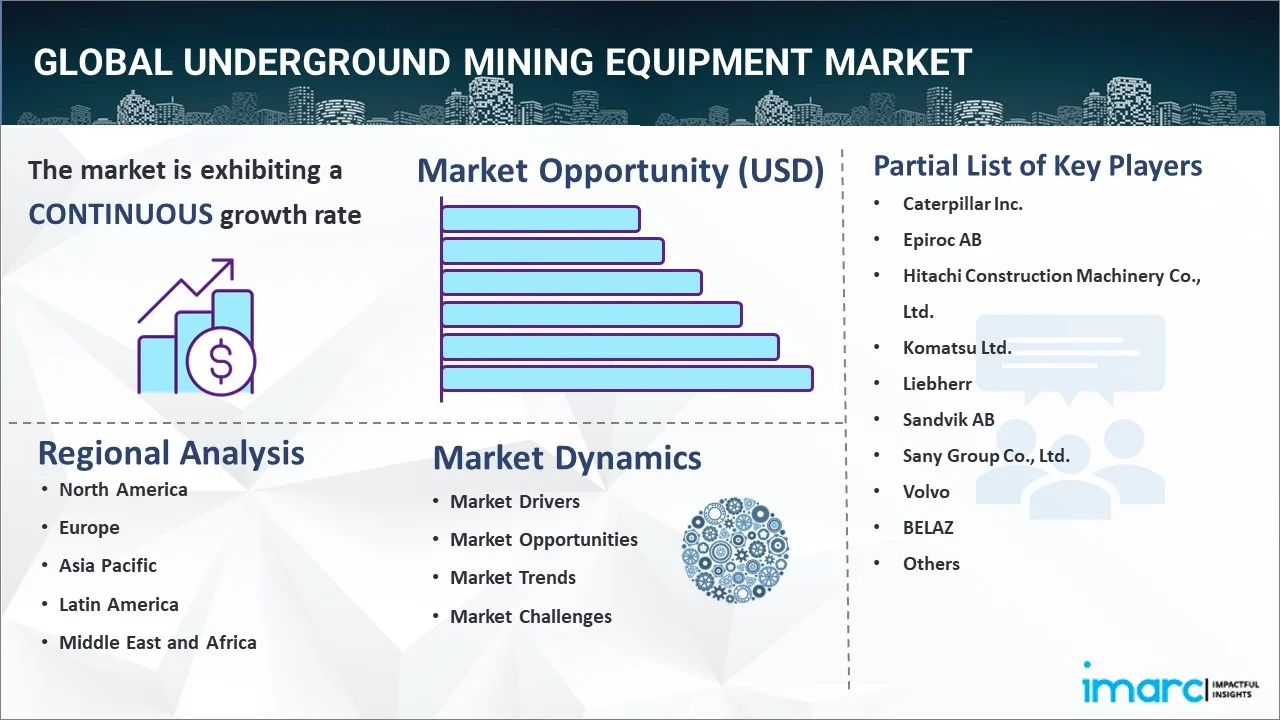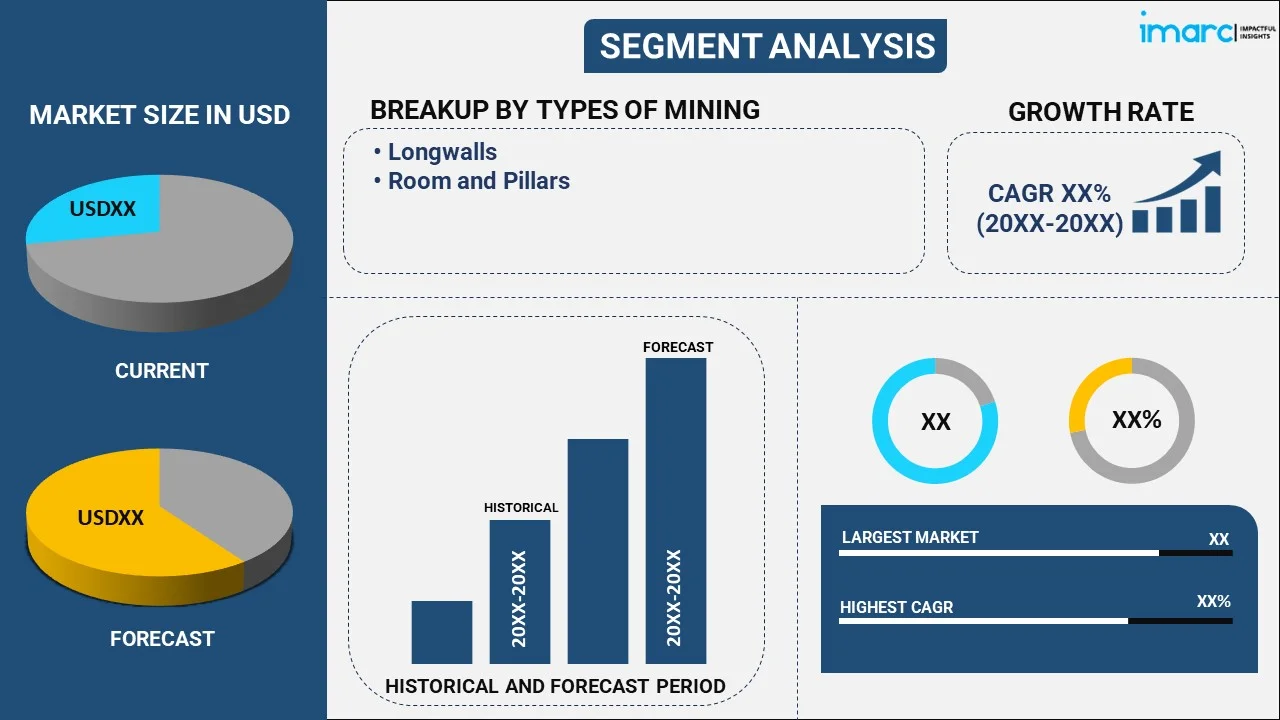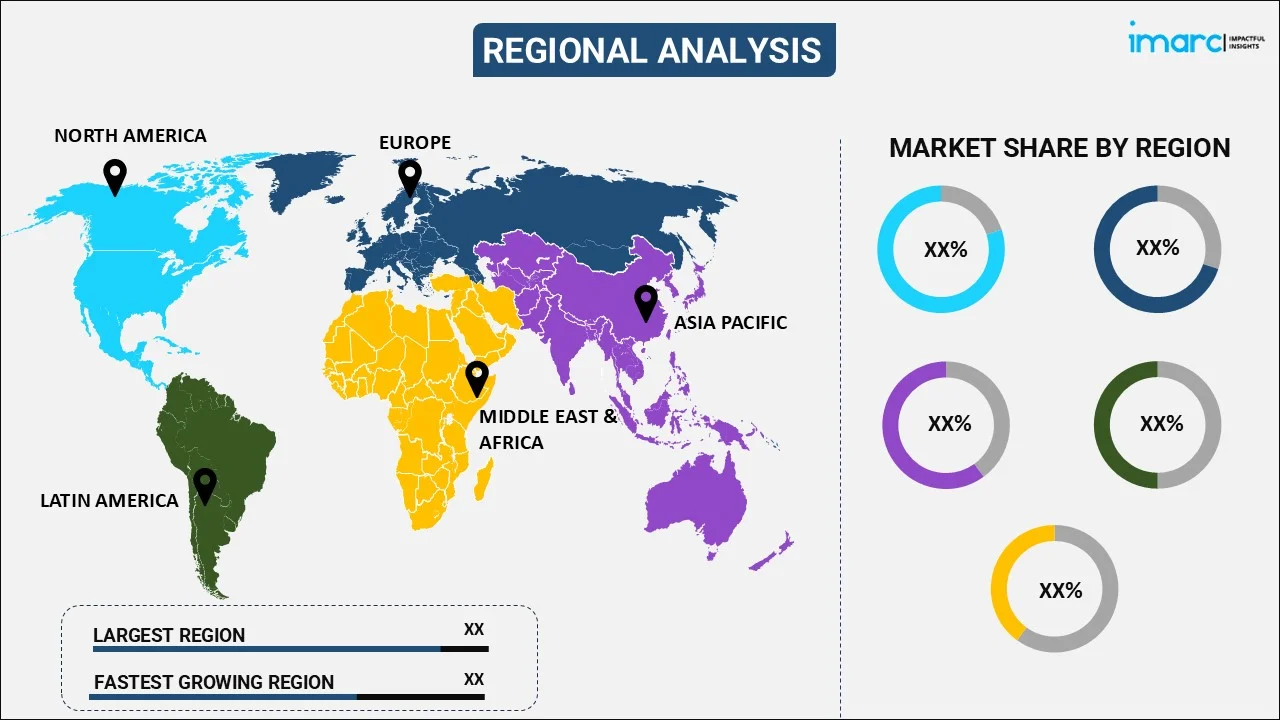
Underground Mining Equipment Market Report by Type of Mining (Longwalls, Room and Pillars), Application (Coal Mining, Metal Mining, Mineral Mining), and Region 2025-2033
Underground Mining Equipment Market Size:
The global underground mining equipment market size reached USD 29.9 Billion in 2024. Looking forward, IMARC Group expects the market to reach USD 39.7 Billion by 2033, exhibiting a growth rate (CAGR) of 3.22% during 2025-2033. The rising demand for minerals and metals, surging focus on safety improvements, rapid technological advancements in automation, stringent environmental regulations, the need for equipment replacement, increased exploration activities, government investments in mining infrastructure, and the trend towards digitalization are some of the factors bolstering the market growth.
|
Report Attribute
|
Key Statistics
|
|---|---|
|
Base Year
|
2024
|
|
Forecast Years
|
2025-2033
|
|
Historical Years
|
2019-2024
|
|
Market Size in 2024
|
USD 29.9 Billion |
|
Market Forecast in 2033
|
USD 39.7 Billion |
| Market Growth Rate 2025-2033 | 3.22% |
Underground Mining Equipment Market Analysis:
- Market Growth and Size: The global underground mining equipment market has exhibited substantial growth, with a notable increase in market size over recent years, driven by the growing demand for minerals and metals worldwide.
- Major Market Drivers: Rising demand for rare earth metals, the global shift toward renewable energy technologies, surging adoption of eco-friendly equipment, increasing global demand for energy resources, including coal, and ongoing exploration activities in untapped regions are some of the key market drivers.
- Technological Advancements: The underground mining equipment market witnesses continuous technological advancements, including automation, remote control systems, and digitalization, enhancing operational efficiency and safety.
- Industry Applications: Underground mining equipment finds applications in various sectors, including coal, metal ores, and minerals, contributing to the industry's versatility.
- Key Market Trends: The adoption of autonomous vehicles and equipment, surging reliance on data analytics for optimized operations, development of equipment with modular designs for flexibility and ease of maintenance, and escalating use of the Internet of Things (IoT) in mining equipment for real-time monitoring are some of the key market trends.
- Geographical Trends: North America leads in the underground mining equipment market due to advanced technology infrastructure, while Asia-Pacific's emerging markets grow rapidly, driven by a rising middle class and escalating mining activities.
- Competitive Landscape: The market is competitive, with companies investing in research and development (R&D) to introduce innovative and sustainable equipment solutions, aiming to differentiate themselves in terms of safety, efficiency, and environmental impact.
- Challenges and Opportunities: Challenges include meeting stringent safety and environmental regulations, while opportunities arise in developing eco-friendly equipment and expanding into emerging mining markets.

Underground Mining Equipment Market Trends:
Increasing demand for minerals and metals
The global underground mining equipment market experiences significant growth due to the escalating demand for minerals and metals across the globe. This surge is primarily fueled by rapid industrialization and infrastructure development across emerging and developed economies. As construction projects and manufacturing sectors expand, the need for raw materials like iron ore, copper, and precious metals intensifies. Additionally, surging demand from mining operations to ramp up their production capacity, driving the adoption of advanced underground mining equipment, which is expected to persist as the global economy continues to grow, emphasizing the crucial role of this driver in shaping the market's trajectory.
Safety concerns and advanced equipment adoption
Safety concerns in underground mining operations have emerged as a paramount driver in the global market. The inherently hazardous nature of underground mining necessitates stringent safety measures. As a result, mining companies are increasingly investing in state-of-the-art equipment designed to enhance safety for workers. They encompass technologies like proximity detection systems, ventilation control systems, and automated equipment, all of which reduce the risk of accidents and improve overall operational safety. The adoption of advanced equipment not only mitigates safety concerns but also enhances efficiency and productivity, making it a pivotal driver influencing the market's growth.
Technological advancements and efficiency gains
Technological advancements have revolutionized the underground mining equipment sector, presenting a crucial drive for market expansion. Innovations such as automation, remote control systems, and the integration of artificial intelligence have transformed traditional mining practices. These technologies enable more precise and efficient extraction of resources, reducing operational costs and enhancing productivity. The ability to remotely operate equipment in hazardous environments not only ensures safety but also extends the lifespan of machinery. Moreover, mining companies are increasingly embracing these innovations to stay competitive and meet the growing demand for minerals and metals, making technological advancement a pivotal driver in the market's evolution.
Stringent environmental regulations and sustainable practices
The global underground mining equipment market is significantly influenced by stringent environmental regulations and the growing emphasis on sustainable mining practices. Governments and environmental agencies are increasingly imposing stricter standards to minimize the ecological footprint of mining operations, which has prompted mining companies to adopt eco-friendly equipment and processes that reduce emissions and waste. Additionally, the use of clean energy sources and innovative water management techniques are becoming integral to underground mining. The drive toward sustainability not only aligns with environmental goals but also enhances the market's image and ensures long-term viability.
Underground Mining Equipment Industry Segmentation:
IMARC Group provides an analysis of the key trends in each segment of the market, along with forecasts at the global and regional levels for 2025-2033. Our report has categorized the market based on the type of mining and application.
Breakup by Type of Mining:

- Longwalls
- Room and Pillars
Longwalls holds the largest share in the industry
The report has provided a detailed breakup and analysis of the market based on the type of mining. This includes longwalls and room and pillars. According to the report, longwalls accounted for the largest market share.
The longwalls segment is driven by the increasing demand for high-efficiency coal extraction methods. Longwall mining is a highly productive technique that allows for the extraction of large coal seams in continuous operation, making it an attractive choice for coal mining companies. The segment's growth is further propelled by the need to maximize coal recovery while minimizing waste and environmental impact. Additionally, advancements in longwall mining technology, such as automation and improved roof support systems, enhance safety and operational efficiency, further fueling the segment's expansion.
Moreover, the room and pillars segment is driven by a different set of factors, primarily associated with the specific geological conditions of coal deposits. It is favored when coal seams are relatively shallow and not thick enough to justify the use of longwall mining. The room and pillars segment's growth is also influenced by the prevalence of such geological formations, which necessitate this approach for coal extraction. Additionally, the ability to leave behind stable pillars of coal provides crucial support to the overlying strata, minimizing subsidence and surface disruptions.
Breakup by Application:
- Coal Mining
- Metal Mining
- Mineral Mining
Coal mining represents the leading market segment
The report has provided a detailed breakup and analysis of the market based on the application. This includes coal mining, metal mining, and mineral mining. According to the report, coal mining accounted for the largest market share.
The coal mining segment is driven by the increasing global demand for energy resources, particularly in developing economies where coal remains a primary source of power generation. Despite the growing focus on renewable energy sources, coal continues to play a vital role in meeting electricity needs. Additionally, the availability of abundant coal reserves in various regions, such as China and the United States, propels the coal mining industry.
The metal mining segment is driven by the increasing demand for metals in various industries, including automotive, construction, and electronics. Metals like iron, copper, and aluminum are essential raw materials for manufacturing, and their demand continues to grow as industrialization and infrastructure development expand globally. Moreover, the rise of electric vehicles (EVs) and renewable energy technologies has amplified the demand for metals like lithium, cobalt, and rare earth elements, driving exploration and extraction efforts.
The mineral mining segment is driven by the increasing need for minerals used in a wide range of applications, from electronics to pharmaceuticals. Rare earth elements are vital components in the production of electronics and clean energy technologies, driving exploration and extraction activities. Additionally, the expansion of construction and infrastructure projects worldwide fuels the demand for minerals like sand, gravel, and limestone. Sustainable mining practices, environmental regulations, and efforts to minimize ecological impact are increasingly shaping the mineral mining industry, emphasizing responsible resource extraction and management.
Breakup by Region:

- Asia Pacific
- North America
- Europe
- Middle East and Africa
- Latin America
Asia Pacific leads the market, accounting for the largest underground mining equipment market share
The market research report has also provided a comprehensive analysis of all the major regional markets, which include Asia Pacific, North America, Europe, Middle East and Africa, and Latin America. According to the report, Asia Pacific accounted for the largest market share.
The Asia Pacific underground mining equipment market is driven by the increasing demand for minerals and metals in the region, spurred by rapid industrialization and urbanization. Furthermore, government initiatives to boost domestic mining activities and investment in infrastructure projects are propelling the market's growth. Additionally, technological advancements and a focus on safety are encouraging the adoption of modern underground mining equipment in the region.
The North American underground mining equipment market is characterized by robust demand stemming from the region's thriving mining industry, particularly in countries like the United States and Canada. The market is further driven by stringent safety regulations and the need for efficient, environmentally friendly equipment.
In Europe, the underground mining equipment market benefits from a strong mining tradition, and it is driven by the modernization of existing mines and the opening of new mines, as well as the emphasis on sustainability and compliance with environmental regulations.
Moreover, the Middle East and Africa underground mining equipment market are influenced by the region's burgeoning mining activities, particularly in countries like South Africa, where mineral resources are abundant. The market is also driven by the need for advanced equipment to enhance safety and efficiency in underground mining operations.
In Latin America, the underground mining equipment market is thriving due to the rich deposits of minerals and metals in countries like Chile and Peru. This is further supported by the continuous demand for copper, gold, and other resources, leading to investments in state-of-the-art mining equipment.
Leading Key Players in the Underground Mining Equipment Industry:
The key players in the global underground mining equipment market are actively engaged in strategic initiatives aimed at maintaining and expanding their market presence. There is a strong focus on research and development (R&D) to introduce innovative and technologically advanced equipment that improves efficiency, safety, and environmental sustainability. Additionally, companies are exploring opportunities for automation and remote monitoring to enhance the operational capabilities of mining equipment. In line with this, many key players are expanding their geographical footprint by entering emerging markets with high mining potential, such as Asia Pacific and parts of Africa. This includes forming partnerships, establishing local subsidiaries, and providing comprehensive aftermarket services to strengthen customer relationships.
The market research report has provided a comprehensive analysis of the competitive landscape. Detailed profiles of all major companies have also been provided. Some of the key players in the market include:
- Caterpillar Inc.
- Epiroc AB
- Hitachi Construction Machinery Co., Ltd.
- Komatsu Ltd.
- Liebherr
- Sandvik AB
- Sany Group Co., Ltd.
- Volvo
- BELAZ
- XCMG Group
(Please note that this is only a partial list of the key players, and the complete list is provided in the report.)
Latest News:
- In October 2021: Caterpillar introduced the R1700 XE, an all-electric underground mining loader. This innovation is designed to reduce emissions, lower operating costs, and improve efficiency, aligning with Caterpillar's commitment to sustainability.
- In June 2021: Epiroc unveiled the Boomer S2, a compact face drilling rig designed for underground mining and tunneling applications. The rig offers improved maneuverability in confined spaces and increased drilling accuracy.
- In November 2021: Sandvik announced the establishment of a new research center for artificial intelligence and automation in Tampere, Finland. The center is focused on developing cutting-edge technologies for underground mining equipment, emphasizing Sandvik's dedication to technological advancements.
Underground Mining Equipment Market Report Scope:
| Report Features | Details |
|---|---|
| Base Year of the Analysis | 2024 |
| Historical Period | 2019-2024 |
| Forecast Period | 2025-2033 |
| Units | Billion USD |
| Scope of the Report | Exploration of Historical Trends and Market Outlook, Industry Catalysts and Challenges, Segment-Wise Historical and Future Market Assessment:
|
| Types of Mining Covered | Longwalls, Room and Pillars |
| Applications Covered | Coal Mining, Metal Mining, Mineral Mining |
| Regions Covered | Asia Pacific, Europe, North America, Latin America, Middle East and Africa |
| Companies Covered | Caterpillar Inc., Epiroc AB, Hitachi Construction Machinery Co., Ltd., Komatsu Ltd., Liebherr, Sandvik AB, Sany Group Co., Ltd., Volvo, BELAZ, XCMG Group, etc. |
| Customization Scope | 10% Free Customization |
| Post-Sale Analyst Support | 10-12 Weeks |
| Delivery Format | PDF and Excel through Email (We can also provide the editable version of the report in PPT/Word format on special request) |
Key Benefits for Stakeholders:
- IMARC’s industry report offers a comprehensive quantitative analysis of various market segments, historical and current market trends, market forecasts, and dynamics of the underground mining equipment market from 2019-2033.
- The research report provides the latest information on the market drivers, challenges, and opportunities in the global underground mining equipment market.
- The study maps the leading, as well as the fastest-growing, regional markets.
- Porter's five forces analysis assists stakeholders in assessing the impact of new entrants, competitive rivalry, supplier power, buyer power, and the threat of substitution. It helps stakeholders to analyze the level of competition within the underground mining equipment industry and its attractiveness.
- The competitive landscape allows stakeholders to understand their competitive environment and provides insight into the current positions of key players in the market.
Key Questions Answered in This Report
The global underground mining equipment market was valued at USD 29.9 Billion in 2024.
We expect the global underground mining equipment market to exhibit a CAGR of 3.22% during 2025-2033.
The introduction of high-quality underground mining equipment by leading manufacturers, along with the growing need for enhancing the yield and productivity, is primarily driving the global underground mining equipment market.
The sudden outbreak of the COVID-19 pandemic had led to the implementation of stringent lockdown regulations across several nations, resulting in the temporary halt in numerous mining activities, thereby negatively impacting the global market for underground mining equipment.
Based on the type of mining, the global underground mining equipment market has been bifurcated into longwalls and room and pillars. Currently, longwalls exhibit a clear dominance in the market.
Based on the application, the global underground mining equipment market can be divided into coal mining, metal mining, and mineral mining. Among these, coal mining holds the largest market share.
On a regional level, the market has been classified into Asia Pacific, North America, Europe, Middle East and Africa, and Latin America, where Asia Pacific currently dominates the global market.
Some of the major players in the global underground mining equipment market include Caterpillar Inc., Epiroc AB, Hitachi Construction Machinery Co., Ltd., Komatsu Ltd., Liebherr, Sandvik AB, Sany Group Co., Ltd., Volvo, BELAZ, and XCMG Group.
Need more help?
- Speak to our experienced analysts for insights on the current market scenarios.
- Include additional segments and countries to customize the report as per your requirement.
- Gain an unparalleled competitive advantage in your domain by understanding how to utilize the report and positively impacting your operations and revenue.
- For further assistance, please connect with our analysts.
 Inquire Before Buying
Inquire Before Buying
 Speak to an Analyst
Speak to an Analyst
 Request Brochure
Request Brochure
 Request Customization
Request Customization




.webp)




.webp)












